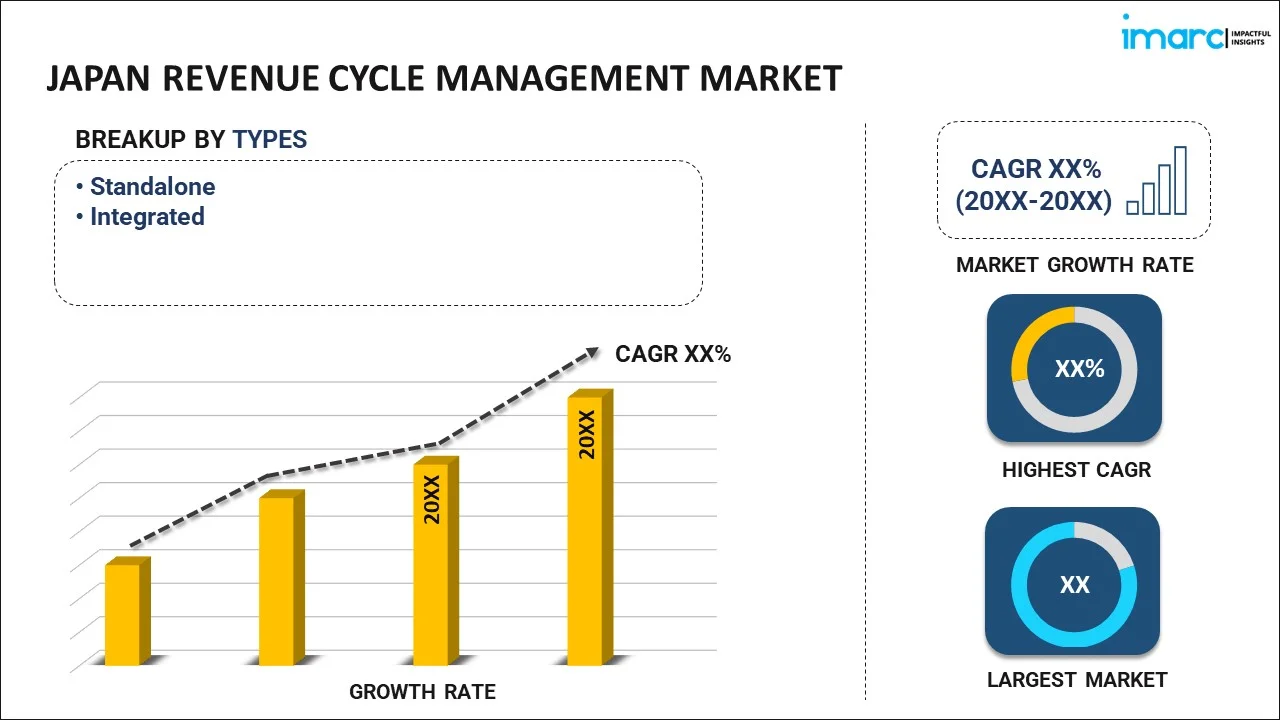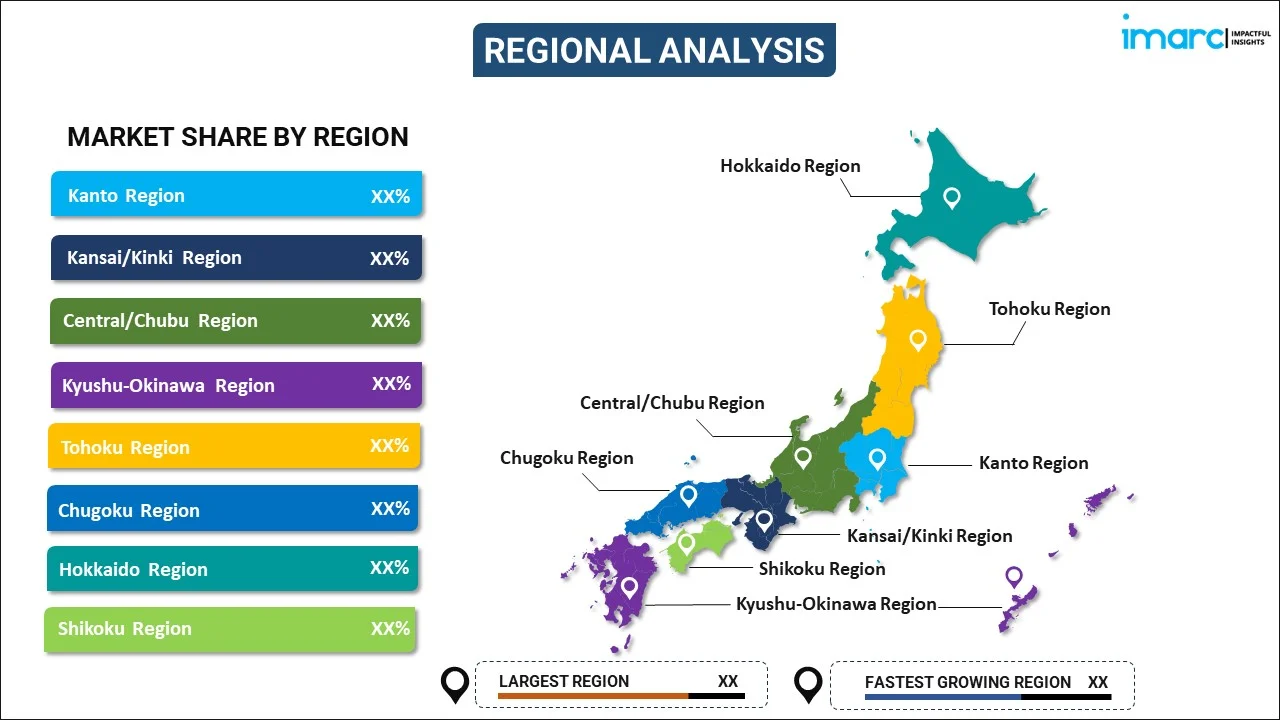
Japan Revenue Cycle Management Market Report by Type (Standalone, Integrated), Component (Software, Services), Deployment (Web-based, Cloud-based, On-premises), End User (Hospitals, Physicians, Diagnostic and Ambulatory Care Centers), and Region 2025-2033
Market Overview:
Japan revenue cycle management market size reached USD 8,807 Million in 2024. Looking forward, IMARC Group expects the market to reach USD 23,973 Million by 2033, exhibiting a growth rate (CAGR) of 11.8% during 2025-2033. The increasing utilization of data analytics and business intelligence in revenue cycle management that helps providers gain insights into their revenue cycle, identify bottlenecks, and optimize processes for better financial performance, is primarily driving the market.
|
Report Attribute
|
Key Statistics
|
|---|---|
|
Base Year
|
2024 |
|
Forecast Years
|
2025-2033
|
|
Historical Years
|
2019-2024
|
| Market Size in 2024 | USD 8,807 Million |
| Market Forecast in 2033 | USD 23,973 Million |
| Market Growth Rate (2025-2033) | 11.8% |
Revenue cycle management (RCM) is a crucial process in the healthcare industry that encompasses all the administrative and clinical functions involved in managing patient service revenue. It begins with patient registration, insurance verification, and appointment scheduling. During a patient's visit, RCM involves coding and documenting medical services, as well as verifying insurance eligibility and benefits. Once the services are provided, RCM focuses on claim submission to insurance companies, followed by the processing of claims and payment posting. It also includes managing denials, appeals, and tracking outstanding balances. Effective RCM ensures timely and accurate reimbursement for healthcare providers, optimizing their financial health. Additionally, RCM involves patient billing and collection efforts, including statements, follow-up on unpaid bills, and payment arrangements. By streamlining and optimizing this entire cycle, healthcare organizations can improve cash flow, reduce billing errors, and enhance overall financial performance, ultimately benefiting both providers and patients. Proper RCM practices are essential to the sustainability of healthcare providers and the delivery of quality patient care.
Japan Revenue Cycle Management Market Trends:
The revenue cycle management market in Japan is thriving due to several key drivers. Firstly, the increasing adoption of electronic health records (EHRs) and healthcare IT systems has streamlined the billing and coding process, reducing manual errors and driving RCM market growth. Furthermore, the growing complexity of healthcare regulations and the need for compliance with codes such as ICD-10 and CPT contribute to the demand for RCM solutions. Additionally, the shift towards value-based care models encourages healthcare providers to optimize their revenue cycles to maximize reimbursements. This transition necessitates robust RCM systems that can efficiently manage claims and track financial performance. Moreover, the ongoing digital transformation in the healthcare industry, which offers end-to-end solutions from patient registration to payment collection, is expected to drive the revenue cycle management market in Japan during the forecast period.
Japan Revenue Cycle Management Market Segmentation:
IMARC Group provides an analysis of the key trends in each segment of the market, along with forecasts at the country level for 2025-2033. Our report has categorized the market based on type, component, deployment, and end user.
Type Insights:

- Standalone
- Integrated
The report has provided a detailed breakup and analysis of the market based on the type. This includes standalone and integrated.
Component Insights:
- Software
- Services
A detailed breakup and analysis of the market based on the component have also been provided in the report. This includes software and services.
Deployment Insights:
- Web-based
- Cloud-based
- On-premises
The report has provided a detailed breakup and analysis of the market based on the deployment type. This includes web-based, cloud-based, and on-premises.
End User Insights:
- Hospitals
- Physicians
- Diagnostic and Ambulatory Care Centers
A detailed breakup and analysis of the market based on the end user have also been provided in the report. This includes hospitals, physicians, and diagnostic and ambulatory care centers.
Regional Insights:

- Kanto Region
- Kansai/Kinki Region
- Central/ Chubu Region
- Kyushu-Okinawa Region
- Tohoku Region
- Chugoku Region
- Hokkaido Region
- Shikoku Region
The report has also provided a comprehensive analysis of all the major regional markets, which include Kanto Region, Kansai/Kinki Region, Central/ Chubu Region, Kyushu-Okinawa Region, Tohoku Region, Chugoku Region, Hokkaido Region, and Shikoku Region.
Competitive Landscape:
The market research report has also provided a comprehensive analysis of the competitive landscape. Competitive analysis such as market structure, key player positioning, top winning strategies, competitive dashboard, and company evaluation quadrant has been covered in the report. Also, detailed profiles of all major companies have been provided.
Japan Revenue Cycle Management Market Report Coverage:
| Report Features | Details |
|---|---|
| Base Year of the Analysis | 2024 |
| Historical Period | 2019-2024 |
| Forecast Period | 2025-2033 |
| Units | Million USD |
| Scope of the Report | Exploration of Historical and Forecast Trends, Industry Catalysts and Challenges, Segment-Wise Historical and Predictive Market Assessment:
|
| Types Covered | Standalone, Integrated |
| Components Covered | Software, Services |
| Deployments Covered | Web-based, Cloud-based, On-premises |
| End Users Covered | Hospitals, Physicians, Diagnostic and Ambulatory Care Centers |
| Regions Covered | Kanto Region, Kansai/Kinki Region, Central/ Chubu Region, Kyushu-Okinawa Region, Tohoku Region, Chugoku Region, Hokkaido Region, Shikoku Region |
| Customization Scope | 10% Free Customization |
| Post-Sale Analyst Support | 10-12 Weeks |
| Delivery Format | PDF and Excel through Email (We can also provide the editable version of the report in PPT/Word format on special request) |
Key Questions Answered in This Report:
- How has the Japan revenue cycle management market performed so far and how will it perform in the coming years?
- What has been the impact of COVID-19 on the Japan revenue cycle management market?
- What is the breakup of the Japan revenue cycle management market on the basis of type?
- What is the breakup of the Japan revenue cycle management market on the basis of component?
- What is the breakup of the Japan revenue cycle management market on the basis of deployment?
- What is the breakup of the Japan revenue cycle management market on the basis of end user?
- What are the various stages in the value chain of the Japan revenue cycle management market?
- What are the key driving factors and challenges in the Japan revenue cycle management?
- What is the structure of the Japan revenue cycle management market and who are the key players?
- What is the degree of competition in the Japan revenue cycle management market?
Key Benefits for Stakeholders:
- IMARC’s industry report offers a comprehensive quantitative analysis of various market segments, historical and current market trends, market forecasts, and dynamics of the Japan revenue cycle management market from 2019-2033.
- The research report provides the latest information on the market drivers, challenges, and opportunities in the Japan revenue cycle management market.
- Porter's five forces analysis assist stakeholders in assessing the impact of new entrants, competitive rivalry, supplier power, buyer power, and the threat of substitution. It helps stakeholders to analyze the level of competition within the Japan revenue cycle management industry and its attractiveness.
- Competitive landscape allows stakeholders to understand their competitive environment and provides an insight into the current positions of key players in the market.
Need more help?
- Speak to our experienced analysts for insights on the current market scenarios.
- Include additional segments and countries to customize the report as per your requirement.
- Gain an unparalleled competitive advantage in your domain by understanding how to utilize the report and positively impacting your operations and revenue.
- For further assistance, please connect with our analysts.
 Inquire Before Buying
Inquire Before Buying
 Speak to an Analyst
Speak to an Analyst
 Request Brochure
Request Brochure
 Request Customization
Request Customization




.webp)




.webp)












